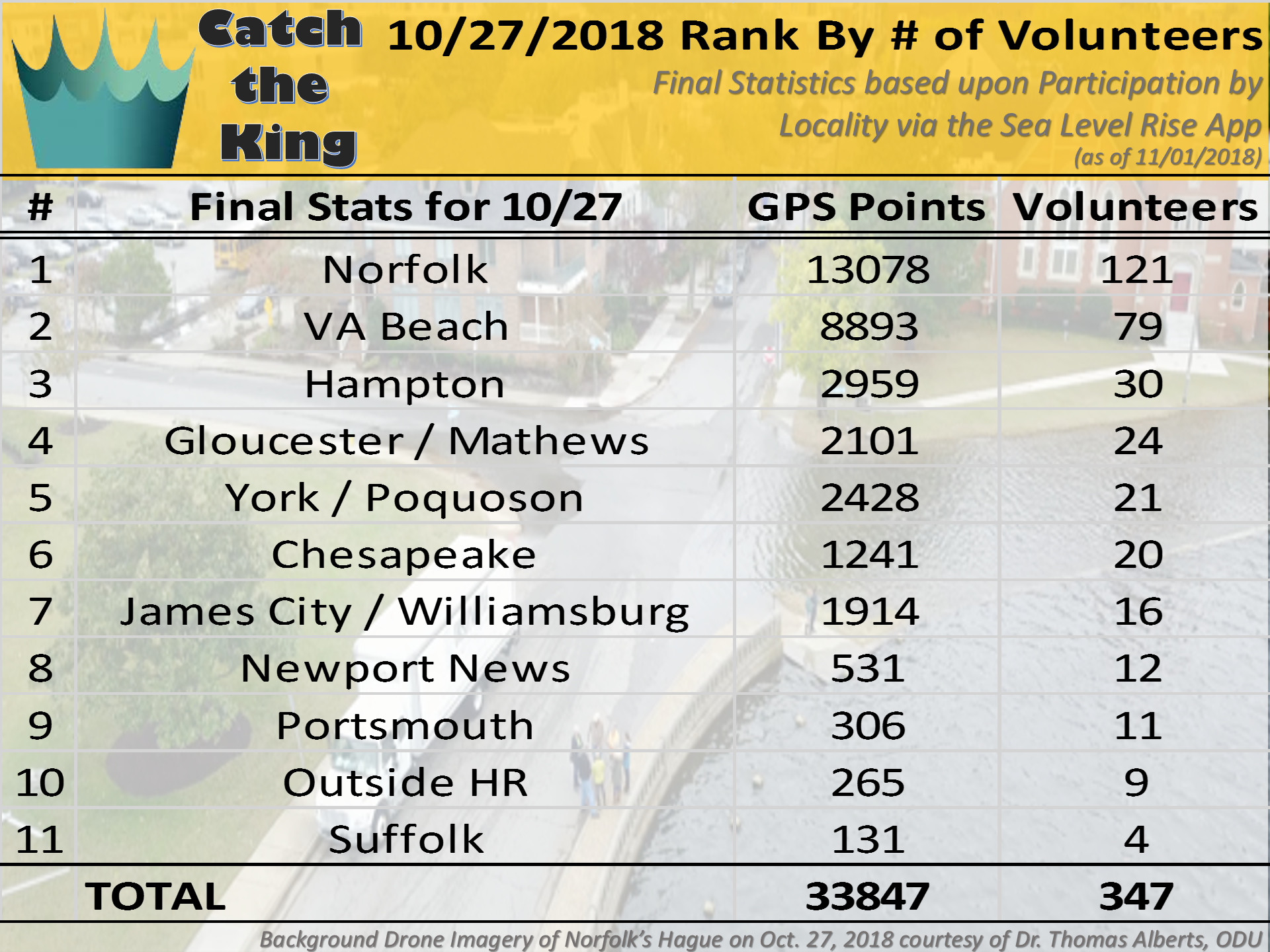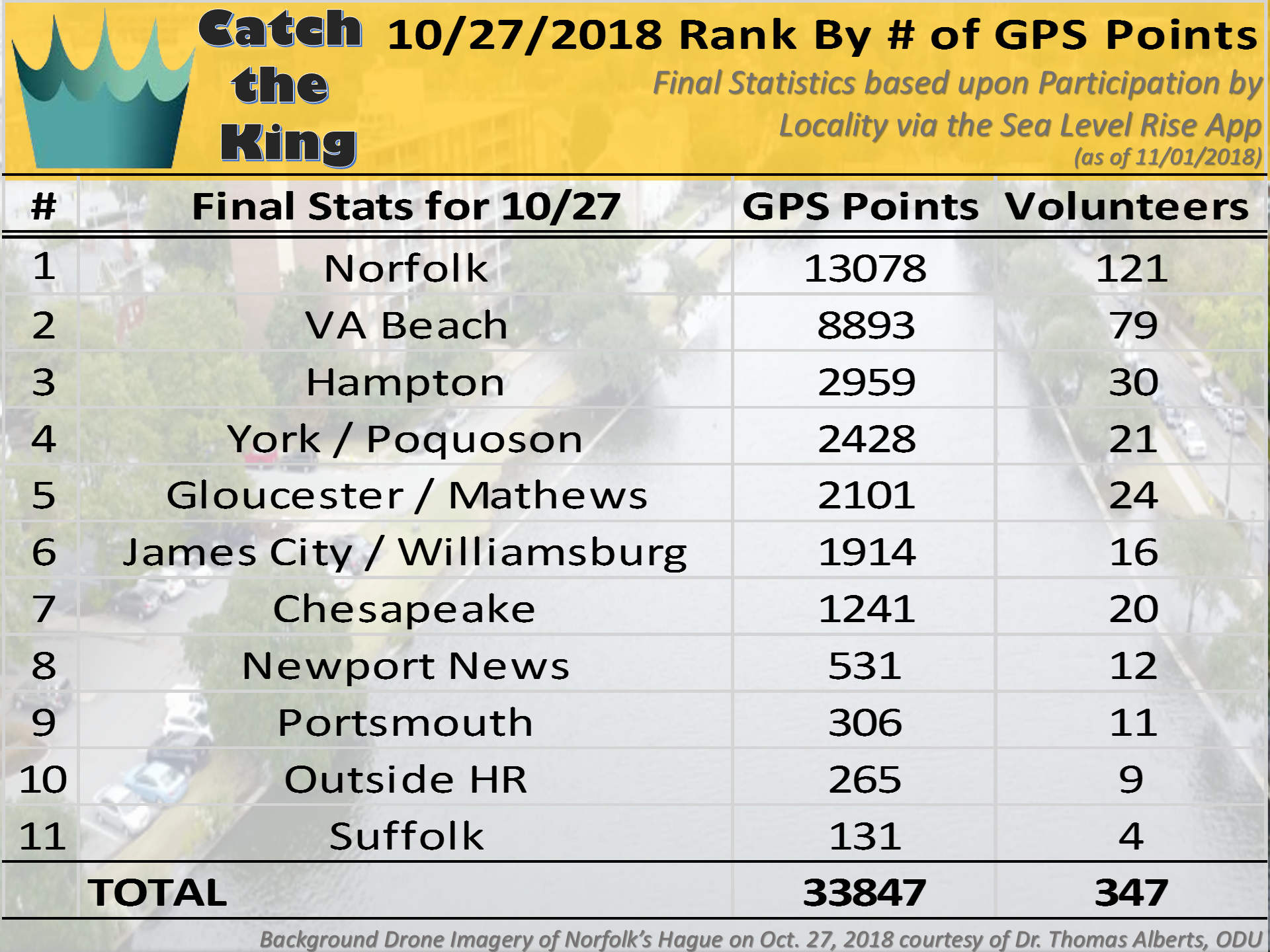'Catch the King' on Oct. 27, 2018
Model-Predicted Maximum Flooding Extents for the King Tide on Oct. 27, 2018 from 09:00 AM - 02:59 PM EDT
"Catch the King" is a citizen-science GPS data collection effort centered in Hampton Roads, VA, that seeks to interactively map the King Tide's maximum inundation extents. The goal is to validate and improving predictive model accuracy for future forecasting of increasingly pervasive "nuisance" flooding. The maximum king tide inundation forecast for Oct. 27, 2018 is shown in the map below:
10/27/2018 - Catch the King Tide Data Map
View Full Screen Map in New Window
Map Legend:
![]() - Blue GPS data points were collected by volunteers to effectively breadcrumb/trace the high water line by pressing the 'Save Data' button in the Sea Level Rise (SLR) App every few steps along the water's edge. These GPS data are collected during the king tide mid-day on Oct. 27th, 2018.
- Blue GPS data points were collected by volunteers to effectively breadcrumb/trace the high water line by pressing the 'Save Data' button in the Sea Level Rise (SLR) App every few steps along the water's edge. These GPS data are collected during the king tide mid-day on Oct. 27th, 2018.
![]() - Red points correspond with water level sensors in the NOAA (10), USGS (18), VIMS (2), and StormSense (28) networks, which are aggregated and ingested into VIMS' Tidewatch Forecasting Network. When selected, those sensor points display current water level forecast information for up to 36-hrs from the present time.
- Red points correspond with water level sensors in the NOAA (10), USGS (18), VIMS (2), and StormSense (28) networks, which are aggregated and ingested into VIMS' Tidewatch Forecasting Network. When selected, those sensor points display current water level forecast information for up to 36-hrs from the present time.
![]() - The blue flood layer superposed with satellite imagery on this interactive map represents forecasted maximum flooding extents for the King Tide happening in Hampton Roads on Saturday, 10/27/2018, from 09:00 AM - 02:59 PM EDT, with the Sea Level Rise App data serving as an effective validation of the model's predictions. These inundation forecast results are depicted using a range of blue hues corresponding with flood depths, and are advised by VIMS' hydrodynamic models and by Tidewatch.
- The blue flood layer superposed with satellite imagery on this interactive map represents forecasted maximum flooding extents for the King Tide happening in Hampton Roads on Saturday, 10/27/2018, from 09:00 AM - 02:59 PM EDT, with the Sea Level Rise App data serving as an effective validation of the model's predictions. These inundation forecast results are depicted using a range of blue hues corresponding with flood depths, and are advised by VIMS' hydrodynamic models and by Tidewatch.
"Catch the King" Initial Participation Statistics
...ranked by region where the greatest number of volunteers and high water marks were collected


Response from the event's numerous volunteers, fueled by the local media partners' coverage leading up to the event, and 42 separate volunteer training events held all over Hampton Roads resulted in an estimated 347 known participants collecting 33,847 time-stamped GPS maximum flooding extent measurements and 458 geotagged photographs of the King Tide flooding during the event. There were additionally 141 volunteers who collected 3,881 GPS data points during the high tide the day/night before the king! Combined, those totals are 488 participants and 37,728 GPS points during the 2018 Catch the King+Nor'easter event. The total number of unique volunteers across both days was 431 people, meaning 57 volunteers mapped the King on Friday and Saturday, 10/26-27. Final assessments calculated this to be 63% of Catch the King 2017's GPS data, 60% of it's volunteer population, and 30% of its picture count (which was intentionally decreased to reduce peak usage stress on the App's server).
Tracking tidal flooding is important, as it gives us a tangible glimpse into the anticipated height of mean tides less than half a century from today. As shown in the interactive plot below, Norfolk in Hampton Roads, VA, has the highest rate of relative SLR acceleration on the US East Coast, as noted in the recent 2018 VIMS Report.
View the 2018 Volunteer Invitation Story Map for Catch the King
Interested volunteers can participate in future citizen science collection events by downloading the "Sea Level Rise" application onto their smartphone, and using the app to trace the high water line from varying locations where they observe inundation. The data will be collected and used to help scientists, educators, and community leaders better understand the risks imposed by the rising tide. To learn more about how the Commonwealth Center for Recurrent Flooding Resiliency is working to help address these issues, visit: http://www.floodingresiliency.org/.
Download All Catch the King 2018 Data:
Attributions: Volunteers of 'Catch the King' Tide 2018 collected these data using the Sea Level Rise mobile application developed by Wetlands Watch and Concursive, Inc. Catch the King 2018 was sponsored and supported by WHRO Public Media, The Virginian-Pilot, the Daily Press, the Hampton Roads Sanitation District, and the CCRFR and orchestrated/managed by Qaren Jacklich and a dedicated team of tide captains and teachers. GPS volunteer data were shared with VIMS for public dissemination via Concursive, Inc. and some schools and volunteers directly.

